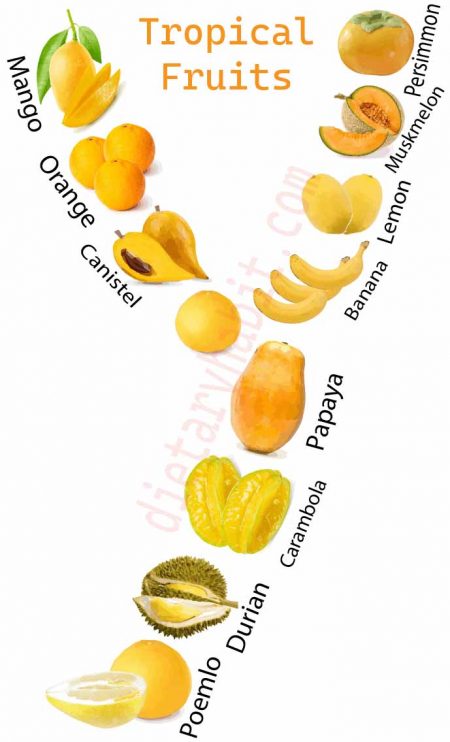A Complete List of Spiky Fruits To Quench Your Curiosity

A fruit covered in spines, thorns, or hair-like structures! How exotic does it sound? It doesn’t seem amusing. But keep in mind that spiky fruits foster such protective shells to fend off the evil souls from picking up the enticing core of the fruits. So what fruit has a spiky shell? We’ll introduce you with a bunch of fruits that have spikes on them. Let’s roll out!
Due to the presence of different phytonutrients, spiky fruits are found in different shades. Here we’ve categorized them according to either their peel or pulp color tones.
- Yellow spiky fruits
- Orange spiky fruits
- Red spiky fruits
- Green spiky fruits
There are some spiky brown fruits also available, but rare. However, a fruit obtains a diversity of colors during its maturation period. Hence, you may find more than one color form of a fruit. Some spiky fruits look spellbound in their exotic appearance. Don’t worry! We’ll let you know about the most exotic spiky fruit on earth!
Here we’ve tried to include spikey fruits according to their color in the matured stage. Some fruits are encompassed here according to the color of the rind, and some are fitted here for the color of their flesh.
Wondering what are those spiky fruits called? We’ve exactly 20 answers for you! Without further ado, it’s time we delve into the complete list of the colorful and exotic spiky fruits.
List of Spiky Fruits
Yellow Spiky Fruits

What are the spiky fruits that are yellow? If you ask someone what is the yellow spiky fruit called? The first answer would be Kiwano melon. Here you’ll get to know more spiky fruits that have yellow outside.
We’ve included the spiky fruits here with either a yellow rind or yellow flesh. Carotenoids are responsible for the yellow coloration of these spiky fruits. Beta carotene is the predecessor of vitamin A. Eating yellow fruits contributes to better eye health. Yellow spiky fruits also prevent macular degeneration and maintain a good skin tone. So what are the yellow spiky fruits called?
1. Pineapple
The big, bright, and vibrant appearance of pineapple is exotic. This spiky yellow fruit is originally from South America. Later, the Spanish and Portuguese colonizers brought it to their colonies worldwide. Its scientific name is ananas comosus.
Pineapple is green when it’s unripe. The more it matures, the more yellowish it becomes. When it evolves into a bright yellow spiked fruit, it tastes the best. The sweet and juicy flesh of pineapple is something heavenly. A green or deep yellow pineapple tastes bitter and gives you a puckering face.
The spikes outside the yellow flesh are meant to keep something valuable intact. Pineapple offers tons of health benefits that include its impressive hydration capacity. The yellow spiky pineapple fruit fends off the invading free radicals in your body.
2. Marang
This Filipino fruit marang, also known as Madang, kirap, taran, closely resembles jackfruit, durian, and cempedak. Non-Asians may find it hard to differentiate among them. These yellow spiky fruits are different in species though they belong to the same genus, Artocarpus.
Marang has soft spikes on its rind, which diffuse a gasoline-like smell. But at its core, this spiky marang tastes like a jackfruit, sweet and flavorful with fewer rags if you eat it as quickly as possible. You can roast and eat the seeds too.
Marang contains essential micronutrients important for our body to function correctly. You can open the marang with two hands with a bit of pressure on the rind. However, this exotic yellow spikey fruit isn’t widely known as it grows only in some specific areas of the Philippines. But as a fruit lover, it’s good to know them.
3. Durian
Durian is a spiky fruit that smells bad. Spiky durian fruit gains notoriety for the bad smell. Many people call durian the ‘king of the fruits’ for its savage, sweet, and succulent fleshes covered with thorns outside. This yellow fruit has sharp spikes which become brittle as it matures.
Durian has the world’s worst stingy smell of fruit. For this, open transportation of this fruit is banned. This spiky fruit is large and oblong. Though the peel is the worst, the arils are too good to taste. The flavor mostly resembles cheesecake and vanilla.
4. Jackfruit
Jackfruit is the dad of all fruits in the genus Artocarpus for the magnitude of its size. I’m very fond of this big spiky fruit. Even the sticky yellow inside of this spiky fruit couldn’t resist me from eating the succulent arils.
Jackfruit mainly grows in the tropical region and is widely found in Asia, Africa, and South America. In southeast Asia, the big yellow spiky fruit is known as ‘kanthal.’ The fleshes are succulent and sweet to eat.
The giant yellow spiky jackfruit produces extra heat after eating. However, the yellow inside heralds the presence of carotenoids from every corner. This spiked yellow fruit helps maintain eye health. It prevents the onset of cataracts and other chronic diseases.
5. Spiny gourd
The spiny gourd is more of a spiky vegetable, known under different pseudonyms such as kakrol, prickly carolaho, bristly balsam pear, kantola, etc. It’s extensively produced in Bangladesh and India. Scientifically, the spiny gourd is named momordica dioica.
The green unripe spiny gourd is healthy to eat, while the ripe yellow one becomes inedible. Drinking kakrol juice is highly beneficial to combat the oxidative challenge. If you’re introduced with a bitter taste, you can take the chance with the juice.
Orange Spiky fruits

What fruit is called orange spiked fruit? Here we’ve included spiky fruits with an orange peel or an orange pulp. Orange fruits contain lots of carotenoids and lycopene which have potent antioxidant activities. You can harness an effective immune system by consuming these phytonutrients found in Orange spiky fruits. The richness in nutrients lulls everyone to have at least a try on their diet plan.
1. African Horned Cucumber
This orange spiky fruit has other common names like horned melon, kiwano, spiked melon, etc. It’s best picked when it’s orange or deep yellow. Inside, the spiky yellow fruit contains lime-green flesh.
Kiwano tastes like a cucumber, and its inside also resembles its closest ally, cucumber. It’s more used in salads, yogurt, etc. The fruit exudes a citrus aroma. It’s a healthy salad which will cut your fat if you eat it every day.
2. Cempedak
Cempedak or Artocarpus integer is another fruit that resembles jackfruit, durian, marang. However, they all are slightly different due to their adaptation to other regions and climates.
Cempedak is more like a jackfruit with soft rubbery spikes and sweet fleshes. Mango and durian flavor also goes in line with this orange spiky fruit. However, this spiky fruit is found in both yellow and orange hues.
Unlike jackfruit, this spiky tropical fruit has a cooling effect on the body. Cempedak is smaller than jackfruit and adopts a tubular shape.
3. Kadam fruit
Burflower tree fruit, aka kadamba fruit, is scientifically named Neolamarckia cadamba. It’s an economically significant fruit with a limited food value. Also, it holds an essential place in the Hindu religion. The medicinal properties of Kadam fruit can’t be ignored.
Kadam fruit becomes exotic and gorgeous when it adorns the orange with soft and fluffy spikes. If you ever come to South Asia, just pick one Kadam fruit on a rainy day. You’ll ruminate over this experience forever.
4. Pandan fruit
Pandanus fruits include different species. All have spikes on their rinds and adorn a yellow, orange, or red appearance with a greenish top. Scientifically known as Pandanus tectorius, this deep orange spiky fruit has other common names, i.e., screwpine, hala tree, pu hala, etc.
Pandanus fruit has a mildly sweet flavor that’s reminiscent of the notion of mango and pineapple. The orange spiky fruit oozes a floral smell with a banana undertone. The edible seed can be eaten both raw and cooked.
5. Chestnut
Chestnuts imply the fruits from different trees and shrubs of the genus Castanea. They include various species, e.g., sweet chestnut, American chestnut, Chinese chestnut, dwarf chestnut, etc. Some chestnuts are rare to find, e.g., American chestnuts.
The history of chestnuts dates back thousands of years. This fruit has been a staple food for some areas like Turkey, South Europe, and Western Asia for many years. Though the shell is solid and hard to break, the healthful flavor of the chestnut is fantastic.
This spiky fruit is eaten cooked rather than raw. Raw chestnut doesn’t taste good as it offers a bitter and crunchy taste. Cooked chestnuts taste buttery with a bit of flavor of the sweet potatoes.
Red spiky fruits

Here we’ve included those spiky fruits which have a red peel or a red pulp. The exotic red spiky fruits are crammed with many phytochemicals, including lycopene. Lycopene is our trustful bodyguard in the fight against oxidative assault. Red spiky fruits help in conserving the youth. So what are the red spiky fruits called?
1. Pulasan
Pulasan is a tropical red fruit that belongs to the soapberry family. It’s very similar to its cousin, rambutan and lychee. Pulasan comes in red, green, deep orange hues with yellowish or brown spikes. They mainly grow in the Malaysian peninsula, where humidity is higher.
Pulasan has thick fleshy arils that taste sweet and can be easily separated from the seeds, unlike rambutan. You can readily eat the pulasan seeds raw. The orange spiky fruit resembles more like a rambutan but has its way of showcasing its unique beauty. The tropical red fruit also offers numerous health benefits.
2. Rambutan
What’s a fruit that looks like a porcupine? The answer is unanimously rambutan. Rambutan is an exotic red fruit with a tough rind. The soft and hairy outside beautifully lines with the sweet and succulent arils inside. However, rambutan came from the Malaysian word ‘rambut,’ which means ‘hair.’
The golf-size white flesh of this red spiky fruit is almost similar to lychee, pulasan, and logan. However, it’s hard to separate the flesh from the seed. Rambutan exhibits a sweet solid profile with a creamy vibe. However, rambutan shows a unique nutrition profile that includes powerful antioxidants.
3. Bayberry
Scientifically known as Myrica rubra, Chinese bayberry has some other familiar names i.e., yangmei, yumberry, Chinese strawberry, waxberry, etc. Yangmei is a Chinese fruit having the highest production rate in Zhejiang. This red spiky fruit also grows in Texas and the Eastern US.
Bayberry tastes sweet but not too much like saccharine. The balanced flavor is reminiscent of strawberry mixed with pomegranate flavor.
This red spiky fruit has medicinal properties as well. It can alleviate sore throat and skin ulcers if used as gargle and ointment, respectively. Bayberry is used to promote carminative and stomachic actions.
4. Lychee
Lychee (Litchi chinensis) is an exotic red spiky fruit with edible white flesh. It’s native to some parts of Southeast Asia. But you may find it worldwide for its juicy and tender meat covering the seed. The spikes aren’t sharp. Rather to they are just little soft prominence in the rind.
Lychee may taste sweet to tart according to the stage of its ripeness. At the early stage of maturity, lychee is a little tart. But when it matures, the sweet and sour combo exudes an aromatic flavor. You’ll remember the evergreen memory of it.
This red spiky fruit has a lot to offer if you eat it every day. Lychee has a large portion of water to hydrate your cells. A fantastic nutrition profile with antioxidants will help you boost your immune system. It keeps the skin tight and smooth.
5. Gac
Gac (Momordica cochinchinensis) is a perennial fruit found mainly in Southeast Asia and some parts of Australia. Gac goes through different colors, green in unripe condition and red in the harvest. You may see a yellow and an orange hue in between the period.
Gac isn’t a sweet fruit at all. The dull and mashy texture often comes with a bitter taste. The peel is inedible, but the pulp is totally fine to continue your culinary practice. Gac is used in Asian cuisine to give the foods a red color.
This red spiky fruit can be bland, but it gives you excellent health benefits. It has ten times more beta carotene than carrots and 12 times lycopene in tomatoes. You’re getting enormous antioxidant functions and efficient support for eye health. What’s more interesting! This red spiky fruit may slower your aging process.
Green spiky fruits

What kind of fruits are green with spikes? Here we’ve listed those spiky fruits with a green rind or a green flesh. The presence of chloroplast in their peel is responsible for the lively green hue. Green fruits are unparallel when it comes to comparing the nutrition profile of the fruits. Green spiky fruits offer lots of medicinal properties as well as mouthwatering flavors.
1. Cherimoya
Cherimoya (Annona cherimola) is an aristocratic fruit, widely known as custard apple and as chirimuya to the Inca people. This green spiky fruit is expensive in the market as the pollination of fruit has to be carefully curated through hand-pollination. Cherimoya closely relates to the soursop and sweetsop in taste and appearance.
The green spiky cherimoya has a blissful blend of candy-like sweetness and custard-like texture. The flavor of this green spiky fruit reminds me of pineapple, strawberry, banana, kiwi, and even papayas. That’s how one can think of this exotic spiky fruit. However, this green spiky fruit’s refreshing and aromatic flavor is revitalizing.
2. Atemoya
This attractive green spiky fruit, atemoya (Annona × atemoya), has a weird scientific name and a weirder production system. It’s a result of crossing between cherimoya and sugar apple. The green appearance is unattractive for insects, and hence hand-pollination is necessary to continue its progeny.
Atemoya has a great combo of sweetness and tartness in its juicy pulp. The seeds are inedible and can be harmful to some people. The fruity flavor reminiscence the vanilla flavor of sugar apple. If you eat this green spiky fruit fresh, you’ll be chilled and revitalized. Antemoya is low in calories and helpful in maintaining high blood pressure.
3. Soursop
Soursop is the edible portion of the tree Annona muricata. It’s widely found in the Caribbean and American tropical regions. Just like cherimoya, soursop belongs to the same genus, Annona. This spiky green fruit, an epitome of a jam-packed nutrient profile, is also known as paw-paw, graviola, sirsak, etc. The green spines on the exterior, though they look weird, protect the white fleshy interior.
The soursop flavor can be best described as the blend between a mango and banana or an apple and a strawberry. Grossly, this green spiky fruit exudes a strong citrus flavor. Soursop may have some side effects, but it’s widely used for its medicinal properties.
4. Sugar-apple
Sugar-apple or sweetsop is the largest growing fruit of the Annona genus. It’s scientifically known as Annona squamosa. In the tropical region of America and the Caribbean region, this green spiky fruit is widely found. However, sweetsop is introduced to America through the Spanish traders who took it from the Philippines.
The name itself suggests the taste. However, this spiky green fruit offers minty flavor and custardy texture. However, sweetsop is low in glycemic index and hence edible for diabetic pate. By eating this spiky tropical fruit, you can maintain a functional immune system.
5. Breadfruit
Breadfruit (Artocarpus altilis) closely relates to jackfruit, cempedak, durian in appearance. However, breadfruit is seldom eaten raw. This green spiny fruit is considered a staple food in some oceanic countries.
Due to the colonial expansion, this fruit is now produced in almost 90 countries. As the texture of the cooked ripe breadfruit resembles freshly baked bread, hence the name comes.
Breadfruit is full of carbohydrates and tastes strongly starchy, more likely a potato. The custardy and bread-like texture is soft but sticky.
Breadfruit is jam-packed with nutrients. It’s a high-yield source of energy. This green spiky fruit enormously helps boost your immunity. Grow a habit of eating such fruit, and your body will fight off infections effectively.
Wrap Up
Spikey fruits don’t always have pointed ends to scare you off. Some of the spiky fruits are really exotic in appearance. Nobody can ignore a yellow spiky fruit, a green spiky fruit, an orange spiky fruit, or a red spiky fruit when you put them on your meal plate. Moreover, the colors have unique health benefits that’ll promote your immunity. Yellow spikey fruits seem to be the most popular, selected by God also. Remember most of the fruits achieve a yellow hue when they mature. If you think we should add any other spiky fruit to this list, let us know in the comment box.

